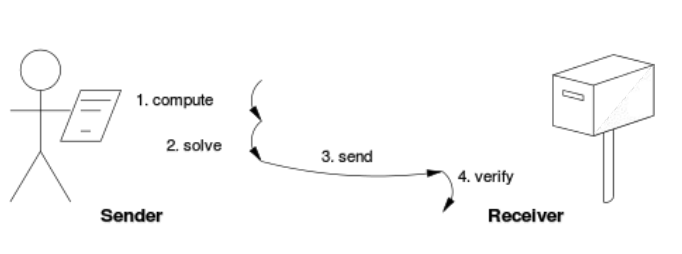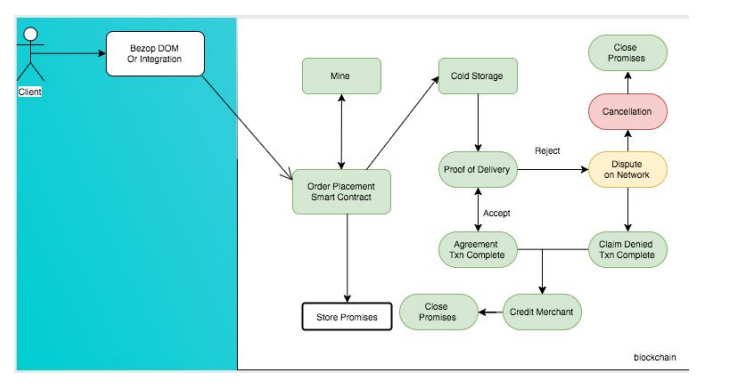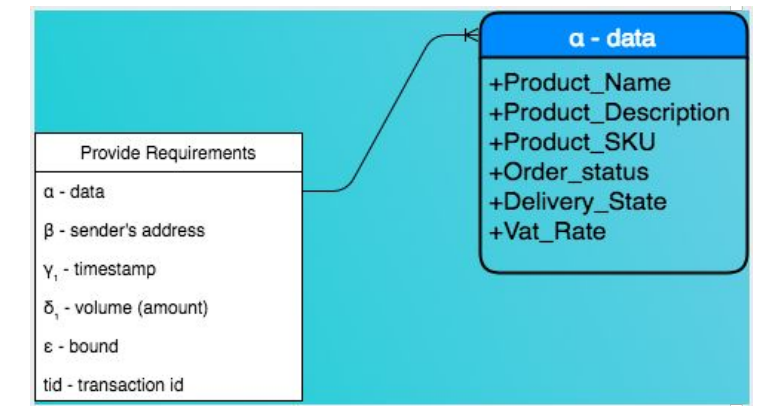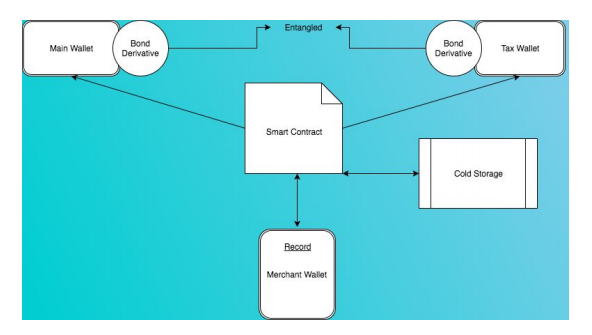BEZOP - a complete solution for launching Internet business in the field of e-commerce
1.Introduction
all of my friends, peace be upon him all
Bezop is a protocol token whose blockchain runs on Proof-of-Work, where blocks are created by miners that are confirming orders (transactions). A proof of work is a piece of data which is difficult (costly, time-consuming) to produce but easy for others to verify and which satisfies certain requirements. Producing a proof of work can be a random process with low probability so that a lot of trial and error is required on average before a valid proof of work is generated. Bezop uses the Hashcash proof-of-work system.
One application of this idea is using Hashcash as a method to preventing email spam, requiring a proof-of-work on the email’s contents (including the To address), on every email. Legitimate emails will be able to do the work to generate the proof easily (not much work is required for a single email), but mass spam emailers will have difficulty generating the required proofs (which would require huge computational resources).
Hashcash proofs of work are used in Bezop for block generation. In order for a block to be accepted by network participants, miners must complete a proof-of-work which covers all of the data in the block. The difficulty of this work is adjusted so as to limit the rate at which new blocks can be generated by the network to one every 10 minutes. Due to the very low probability of successful generation, this makes it unpredictable which worker computer in the network will be able to generate the next block.
For a block to be valid it must hash to a value less than the current target; this means that each block indicates that work has been done generating it. Each block contains the hash of the preceding block, thus each block has a chain of blocks that together contain a large amount of work. Changing a block (which can only be done by making a new block containing the same predecessor) requires regenerating all successors and redoing the work they contain. This protects the block chain from tampering.
The most widely used proof-of-work scheme is based on SHA-256 and was introduced as a part of Bitcoin. Some other hashing algorithms that are used for proof-of-work include Scrypt, Blake-256, CryptoNight, HEFTY1, Quark, SHA-3, scrypt-jane, scrypt-n, and combinations thereof.
There are two classes of proof-of-work protocols.
● Challenge-response protocols assume a direct interactive link between the requester (client) and the provider (server). The provider chooses a challenge, say an item in a set with a property, the requester finds the relevant response in the set, which is sent back and checked by the provider. As the challenge is chosen on the spot by the provider, its difficulty can be adapted to its current load. The work on the requester side may be bounded if the challenge-response protocol has a known solution (chosen by the provider), or is known to exist within a bounded search space.
● Solution-verification protocols do not assume such a link: as a result the problem must be self-imposed before a solution is sought by the requester, and the provider must check both the problem choice and the found solution. Most such schemes are unbounded probabilistic iterative procedures such as Hashcash.
Known-solution protocols tend to have slightly lower variance than unbounded probabilistic protocols, because the variance of a rectangular distribution is lower than the variance of a Poisson distribution (with the same mean). A generic technique for reducing variance is to use multiple independent sub-challenges, as the average of multiple samples will have lower variance.
1.1 Elementary Components
The Bezop protocol builds upon four novel components.
i. Decentralized Order Management (DOM) : Open Source order management and fulfilment portal
ii. Bezop Network : A smart contract friendly blockchain network
iii. Proof of Order :A brief overview on the various proof’s,
We present these novel Proofs-of-Order in detail (Section 3) .
a. Proof-of-Tax : — a vat transaction holds data
(i) pointing to the main transaction .
— x must be computed for correctness by taking the hash of γ.Φ
Tax Data : { α|obj : val , γ|str: val, δ|float : val, ε:bool:val, x|str:val}
α — data , γ — timestamp ,γ₁ — timestamp of parent transaction
δ — volume ,δ₁ — volume of parent transaction
ε — bound (inbound :1 , outbound : 0)
Φ — val(γ₁.δ₁) i — tid of original transaction
x — correctness byte [ hash(γ.Φ) ]
b. Proof-of-Transaction : Serves a receipt, and shows all information about the product or service purchased.
Transactional Data : { α|obj : val , β|str : val, γ₁|str: val, δ₁|float : val, ε:bool:val, tid|str : val }
α — data (see page XX)
β — sender’s address , γ₁ — timestamp , δ₁ — volume (amount)
ε — bound (inbound :1 , outbound : 0) , tid — transaction id
iv) Proof-of-Delivery : Proofs that a product or service was delivered.
v) Bezop Smart Contracts & Promises : Smart contracts will enable a completely safe and trustless ecommerce solution working flawlessly together on the proof of order protocol and ensuring buyer protection is made available via the blockchain.
Others :
i Correctness : correctness of an algorithm is asserted when it is said that the algorithm is correct with respect to a specification. Functional correctness refers to the input-output behaviour of the algorithm (i.e., for each input it produces the expected output).
A distinction is made between total correctness, which additionally requires that the algorithm terminates, and partial correctness, which simply requires that if an answer is returned it will be correct. Since there is no general solution to the halting problem, a total correctness
assertion may lie much deeper. A termination proof is a type of mathematical proof that plays a critical role in formal verification because total correctness of an algorithm depends on termination.
For example, successively searching through integers 1, 2, 3, … to see if we can find an example of some phenomenon — say an odd perfect number — it is quite easy to write a partially correct program (using long division by two to check n as perfect or not). But to say this program is totally correct would be to assert something currently not known in number theory.
Proof-of-Work :
Bezop will be based on the same POW system as Ethereum , which will further be upgraded to our full ‘proof of order’ where miners do not need to spend computation to mine blocks, but instead confirm orders on the network.
- 2 Ethereum Network , ERC20 Token :
Ethereum is a decentralized platform that runs Bezop , using the power of smart contracts provided by the Ethereum network sales of goods and services, common transactions occurs without any possibility of downtime, censorship, fraud or third party interference.
Bezop runs on a custom built blockchain (Ethereum), which is enormously powerful, transparent and a global infrastructure that can move value around and represent the ownership of property. Which will enable us to create the Bezop markets, store registries of transactions,deliveries, order status, tax and also move funds in accordance with instructions given long in the past (like a will or a futures contract) and many other things that have not been invented yet, all without a middleman or counterparty risk.
- 3 Protocol Overview :
- The Bezop protocol is a decentralized ecommerce network built on a blockchain and with a native token. Clients spend tokens in exchange for goods, services, triggering contracts and retrieving tax proof.
- Miners earn by confirming orders (transactions) and resolving disputes.
• The Bezop DOM handle orders on the frontend. Store Owners set the price for their product/service and VAT rate and add them to their self operated Bezop platform, Customers send tokens which serve as credit for the goods and service.
- The markets are operated by the Bezop network which employs Proof-of-Work and Proof-of-Order to guarantee that miners have correctly done work to confirm the order.
- Finally, miners can participate in the creations of new blocks for the underlying blockchain. The influence of a miner over the next block is proportional to the amount of active orders in the network.
Protocol Overview
1.3 Paper organization
The remainder of this paper is organized as follows. We present our definition of and requirements for a DOM in Section 2.
In Section 3, we motivate, define, and present our Proof-of-Order, (Proof Of Transaction and Proof-of-Tax), used within Bezop
In Section 4, we provide a brief description of Smart Contracts within the Bezop.
We conclude with a discussion of future work in Section 5.
2.1 Definition of a Decentralized Order Management
Decentralized Order Management (DOM) is a fully developed ecommerce platform which any interested user can download , host, and run without any central governance or external control.
Users can run a pull request on the Bezop’s DOM from github to their self-operated web server . They can start selling their products and services in exchange for Bezop tokens in a matter of minutes.
2.2 Technologies
Bezop DOM is built with HTML5, ReactJS , NodeJs , MongoDB Which are all open source languages.
2.2 Requirements Running
Bezop DOM requires installation of the following dependencies
— Linux
— Nginx
- NodeJs
— Npm (Node Package Manager)
— MongoDB
2.3 Properties (Described by Real-Life Case Analysis)
(i) Store Creation :
Problem Analysis A — Client 0:
Jane is the owner of a small business where she sells Sports outfit and kits for USD 10–150. She wanted to expand and build her own digital store where she can easily transact with her clients online without the frustration of losing massive fees per transaction or monthly fees to access a centralized portal.
Bezop Solutions A :
With Bezop DOM , Jane can instantly run a fully decentralized ecommerce portal. Without the need for PrestaShop , Shopify , Amazon and other centralized ecommerce stores that requires heavy transaction and monthly payments.
Problem Analysis B — Client 1:
John is the owner of a medium scale business and sells electronics for USD 99–1999. he recently got an online store but in constant dispute with his merchant service providers. He waits 21 days for credits to clear into his account and prefers not to wait that long to send funds back to his suppliers.
Bezop Solutions B :
With Bezop DOM , John is not governed by any central body and can process their own transaction by linking the Bezop main address and Bezop tax address into Bezop DOM online store. His funds are automatically clears few days after proof of delivery.
3) Proof Of Order
Allows proving a transaction occurred. In the case of a purchase, it must provide (sufficient proof) the service was delivered, a valid proof of tax (vat collection) and proof of correctness for a single or chain of transactions.
The proof of order adds ‘legitimacy’ and ‘legality of purpose’ to every transaction on the Bezop network while remaining decentralized, anonymous and trustless.
Consensus for complete ‘Proof of Order’
— Sellers must convince the network that they have delivered the paid products, service or software in good condition; Sellers will generate Proofs-of-Delivery that the blockchain network may verify
— Blockchain Network must store proof of transaction
— Blockchain Network may generate proof of tax
In this section, we motivate, present and outline implementations for the Proof-of-Delivery (PoD) and Proof-of-Transaction (PoT) and Proof-of-Tax (PoT) schemes used in Bezop.
Motivation
Proofs-of-Order schemes such as Proof-of-Delivery (POD) and Proof-of-Transaction (PoT) schemes allow the network (N) to track present state and store transaction data a smart contract protocol with the user.
POD scheme guarantees that an order is delivered.
Attacks In Bezop, we need stronger guarantees to prevent three types of attacks that malicious
sellers could exploit to get paid for products and services they are not providing:
Rogovy attack,
Permanent Eclipse Attack Rogovy Attack:
This is a kind of attack where several merchants turn rogue and mark large number of orders as delivered while the actual delivery is not as described. In this case a buyer ends up paying for what they cannot use.
The attacker(s) must own multiple merchant addresses and rapidly trigger Proof-of-Delivery Smart Contract Protocol with the aid of a bot. The faith of this attack falls on the client’s ability to respond in timely fashion.
Permanent Eclipse Attack :
This is a consensus critical vulnerability in the Ethereum peer-to-peer protocol. If the vulnerability is exploited an eclipse attack could cause Denial-of-Service and that can also be used by an adversary to double spend transactions. Due to the low resource requirements of the attack, an attacker with limited capabilities can easily sustain an attack on the whole ethereum network (ultimately Bezop).
Components for Bezop-Ethereum Eclipse Attack
The attack appears to be a vulnerability in the peer-to-peer protocol. However, it was only tested with the geth client.
— Block Propagation Blocks are propagated in three different ways in the Ethereum network. Firstly, a node B that receives a new block, will directly push the block to √n of its connected peers, where n is the total number of connected peers. Secondly, B will send a NewBlockHashes message to all of its peers, advertising a new block.
When a node A receives an advertisement, it will request the block explicitly after 0.5 seconds from a random peer from which it received a corresponding advertisement (unless A received the block from another peer in the meantime) and then forgets about all other advertisements for that block. This means that if A requests the block from B and B fails to answer, it will not request the block from any other peers. If A misses a block, the third method for block propagation is used, which is the block synchronisation explained below in section 1.3.2.
— Block Synchronisation
A node will only synchronise with one other node at a time. A node “A” starts a block synchronisation
in the following cases:
“A” starts a connection to a new peer with higher advertised total difficulty (e.g. after joining or rejoining the network). “A” node advertising a higher total difficulty than “A” connects to “A”. “A” receives a block with higher total difficulty than the head of its current blockchain and is missing some of the blocks ancestors
Bezop Mining
If we had access to a trustworthy centralized service, this system would be trivial to implement; it could be coded exactly as described, using a centralized server’s hard drive to keep track of the state. However, with Bitcoin we are trying to build a decentralized currency system, so we will need to combine the state transition system with a consensus system in order to ensure that everyone agrees on the order of transactions. Bitcoin’s decentralized consensus process requires nodes in the network to continuously attempt to produce packages of transactions called “blocks”. The network is intended to create one block approximately every ten minutes, with each block containing a timestamp, a nonce, a reference to (i.e., hash of) the previous block and a list of all of the transactions that have taken place since the previous block. Over time, this creates a persistent, ever-growing, “blockchain” that continually updates to represent the latest state of the Bitcoin ledger.
The algorithm for checking if a block is valid, expressed in this paradigm, is as follows:
● Check if the previous block referenced by the block exists and is valid.
● Check that the timestamp of the block is greater than that of the previous block and less than 2 hours into the future
● Check that the proof of work on the block is valid
● Let S[0] be the state at the end of the previous block
● Suppose TX is the block’s transaction list with “n” transactions. For all, i in 0…n-1, set S[i+1] = APPLY(S[i],TX[i]) If any application returns an error, exit and return false
● Return true, and register S[n] as the state at the end of this block
Essentially, each transaction in the block must provide a valid state transition from what was the canonical state before the transaction was executed to some new state. Note that the state is not encoded in the block in any way; it is purely an abstraction to be remembered by the validating node and can only be (securely) computed for any block by starting from the genesis state and sequentially applying every transaction in every block. Additionally, note that the order in which the miner includes transactions into the block matters; if there are two transactions A and B in a block such that B spends a UTXO created by A, then the block will be valid if A comes before B but not otherwise.
The one validity condition present in the above list that is not found in other systems is the requirement for “proof-of-work”. The precise condition is that the double-SHA256 hash of every block, treated as a 256-bit number, must be less than a dynamically adjusted target, which as of the time of this writing is approximately 2187. The purpose of this is to make block creation computationally “hard”, thereby preventing Sybil attackers from remaking the entire blockchain in their favor. Because SHA256 is designed to be a completely unpredictable pseudorandom function, the only way to create a valid block is simply trial and error, repeatedly incrementing the nonce and seeing if the new hash matches.
For instance,a target of ~2187, the network must make an average of ~269 tries before a valid block is found; in general, the target is recalibrated by the network every 2016 blocks so that on average a new block is produced by some node in the network every ten minutes. In order to compensate miners for this computational work, the miner of every block is entitled to include a transaction giving themselves 12.5 BTC out of nowhere. Additionally, if any transaction has a higher total denomination in its inputs than in its outputs, the difference also goes to the miner as a “transaction fee”. Incidentally, this is also the only mechanism by which BTC are issued; the genesis state contained no coins at all.
In order to better understand the purpose of mining, let us examine what happens in the event of a malicious attacker. Since Bitcoin’s underlying cryptography is known to be secure, the attacker will target the one part of the Bitcoin system that is not protected by cryptography directly: the order of transactions. The attacker’s strategy is simple:
- Send 100 BTC to a merchant in exchange for some product (preferably a rapid-delivery digital good).
2. Wait for the delivery of the product.
3. Produce another transaction sending the same 100 BTC to himself.
4. Try to convince the network that his transaction to himself was the one that came first.
Once step (1) has taken place, after a few minutes some miner will include the transaction in a block, say block number 270,000. After about one hour, five more blocks will have been added to the chain after that block, with each of those blocks indirectly pointing to the transaction and thus “confirming” it. At this point, the merchant will accept the payment as finalized and deliver the product; since we are assuming this is a digital good, delivery is instant. Now, the attacker creates another transaction sending the 100 BTC to himself. If the attacker simply releases it into the wild, the transaction will not be processed; miners will attempt to run APPLY(S,TX) and notice that TX consumes a UTXO which is no longer in the state. So instead, the attacker creates a “fork” of the bitcoin blockchain, starting by mining another version of block 270,000 pointing to the same block 269,999 as a parent but with the new transaction in place of the old one. Because the block data is different, this requires redoing the proof of work for the concerned block. Furthermore, the attacker’s new version of block 270,000 has a different hash, so the original blocks 270,001 to 270,005 do not “point” to it; thus, the original chain and the attacker’s new chain are completely separate. The rule is that in a fork the longest blockchain is taken to be the truth, and so legitimate miners will work on the 270005 chain while the attacker alone is working on the 270,000 chain. In order for the attacker to make his blockchain the longest, he would need to have more computational power than the rest of the network combined in order to catch up (hence, “51% attack”). Bitcoin blocks depend on the hash of all previous blocks. An attacker with immense computing power can redo the proof of work (PoW) for a considerate amount of blocks and can eventually gain a lot of bitcoins but as described in Satoshi’s paper,the reward to mine a valid block is much more than to disrupt the network. But in light of falling mining rewards the same does not hold true.
Proof Of Transaction and Delivery
PoT : A digital ‘Proof of transaction’ is generated by the Bezop network for any and all sale of goods and services, it is publicly viewable, immutable and preserves anonymity for both parties.
Transactional Data : { α|obj: val , β|str : val, γ₁|str: val, δ₁|float : val, ε:bool:val, tid|str : val }
α — data , β — sender’s address , γ₁ — timestamp , δ₁ — volume (amount)
ε — bound (inbound :1 , outbound : 0) , tid — transaction id
α — data is an object containing
Product_Name
Product_Description
Product_SKU
Order_status
Delivery_State
Vat_Rate
Fig Proof Of Transaction (Data Structure)
PoD : Proof of delivery (POD) is a method to establish the fact that the recipient received the contents sent by the sender. When the sender sends multiple physical goods or digital content, there is a possibility of some not reaching the intended recipient.
Proof of delivery becomes very important when legal and financial documents are to be exchanged between two parties. In the United States, DHL, UPS and FedEx as well as the US postal service (USPS) provide proof of delivery. Commercial fleet operators also need to be able to confirm proof of delivery of goods to their customers.
In ecommerce, businesses exchange millions of electronic documents to track delivery information using computer to computer communication techniques like email, FTP and EDI. These documents contain a variety of transaction details, including information regarding purchase orders, invoices, shipping details, product specifications, and price quotes. Electronic documents can exchange new data as well as corrections to previously transmitted messages.
Legal complications can arise if the recipient’s company refutes receiving a corrected product specification or a message about a delayed shipment. Both companies could be at loggerheads, each proving/not proving the existence of that particular communication.
Decentralized proof of delivery is similar in function however works in reverse, the shipper/store owner Is liable to provide a ‘proof of delivery’ within 30days of marking the order as shipped on the network, this can be done through the DOM which is linked to the receiving wallet ; the options are
a) Providing a link to scanned delivery document
b) Providing link to proof of delivery screenshot
c) tracking number of the package
Providing proof of delivery requires a gas fee which Miners will use to confirm the delivery. Once delivery is approved by a miner, the order state is changed to “ has been provided”, the order is deemed fulfilled, and order_status is updated.
Proof Of Tax
A digital ‘Proof of tax’ is generated and stored on the Bezop network for transactions related to sales of goods and services. Bezop’s DOM provides a powerful feature which allows users to collect VAT for their products to their secondary wallet address which the network automatically issues to all Bezop account holders. A proof of tax is publicly viewable, immutable and preserves anonymity for both parties.
A tax wallet operates just like a standard wallet with the exception that it is entangled/bonded to the main address using an easily computable hash known as the bond-derivative. The purposes a tax wallet serves are listed below :
- Collecting Value Added Tax ( VAT )
2) Automatic calculation and generation of tax report
A tax report stored on blockchain is immutable and resistant to loss
Cases
Your Accountant Moves or Closes
Situation: Yesterday, I found myself in quite a predicament when I couldn’t get in contact with my old accountant. Turns out his office had closed business just when I needed him to give me a copy tax return to refinance my home. I had been careless and hadn’t saved a copy, and had never been really bothered that I hadn’t because I always thought my CPA was my backup for maintaining copies of my past tax return and my insurance for that… too bad I was wrong. So what do you do if you find yourself in a similar situation and your tax coach is missing in action?
YOU move and threw away all your papers or just shredded your last tax return copy
Situation: I recently relocated to be closer to my family and my loved ones, but realized that I threw away my last year’s tax return copy. I thought for some reason I wouldn’t need it, and how my tax preparer is far away and not picking up. My son is going to college and applying for financial aid-I need it to help him get settled here and so I have a piece of mind. How do I get a copy of an old tax return quickly and securely?
You lost your copy of your tax return in a fire or flood
Situation: My family and I just went through a harrowing ordeal of losing our home to a brush fire. Everyone is safe and no one was hurt, but now I have to build my life all over from scratch and I don’t even know where to begin. I know I need to get my finances together and to do that I need a copy of my tax returns. I know there’s some way to get a copy without having to wait so long for the IRS to send them — I’m homeless and scared I want someone to help me right now! Is there any way I can get a copy of my past tax return and the help that I need?
Your computer crashed with all your copies of tax returns download
Situation: I’m a grad student who is detailed, studious, and organized. But yesterday my computer suddenly crashed with a virus and now I have no access to my tax return copies I filed and saved electronically! I need my financial documents for the bar exam, for my own recordkeeping, and the new lease application that’s due tomorrow! Help! Where can I go to ask for help to get a copy of my old tax return at 3AM in the morning?
3) Smart Contracts
3.1 Contracts in Bezop : Smart contracts will enable a completely safe and trustless ecommerce solution on the proof of order protocol and ensuring buyer protection is made available via the ethereum blockchain.
A number of smart contracts, detailed structure and functionality will be defined in this section and finalized with more research. To illustrate the intended functionality, we provide sample workflows illustrating the purchase, cancellation, claim process, and dispute handling on the blockchain.
Merchant Wallet (powered by smart contract): Buyer protection is a critical problem in ecommerce. Bezop DOM (decentralized order management) system is designed to only work with specialized wallets. A standard Bezop wallet is comprised of a
“main wallet” and a “tax wallet” entangled using an easily computable hash known as “bond-derivative”.
The Merchant wallet is a simple smart contract on the blockchain that does the work of a middle-man (escrow system) and keeps both the client and merchant safe. The contract transfers a client’s funds into cold storage. Which is unlockable only after (X) days when proof-of-delivery is provided by the merchant. If a merchant fails to provide PoD, the buyer will have the option to cancel.
Simple Figure shows the merchant/contract wallet design, how the main wallet and tax wallet are linked with a bond-derivative )
Merchant Wallet Creation (smart contract)
A merchant wallet simulates the behaviour of a normal wallet however it is based on a contract address and operated autonomously.
X signifies the number of days before shipment can be made. This is specified by the merchant while creating their merchant wallet.
Decentralized Dispute Agent
dispute agents can verify the proof of delivery provided by the merchant using the instructions and decide to resolve in favor of the client or merchant. Further input is not needed by the merchant or client.
4 Future Work
This work presents a clear and cohesive path toward the construction of the Bezop network; however, we also consider this work to be a starting point for future research on decentralized ecommerce systems. In this section we identify and populate three categories of future work. This includes work that has been completed and merely awaits description and publication, open questions for improving the current protocols, and formalization of the protocol.
4.1 On-going Work
Shapeshift Integration
Rainbow wallet
Bezop DOM
Smart Contracts
Bezop Dom Wallet Integration
Product Addition To Network
4.2 Open Questions
Will Bezop feature product rating ?
Yes , future smart contracts will allow users to add products into the network and all purchases must be be related to products on the network.
Post purchase , a client will have an extra option to post a rating after proof of delivery is submitted.
Will Bezop split off to its own network ?
Bezop is such a massive concept that a split out of the etheruem network is imminent
Once we have a stable product.
See the whitepaper roadmap — http://bezop.org/whitepaper.pdf
Does Bezop host stores for merchants?
At the moment , no .
In the future we may consider that as blockchain becomes more scalable
Merchants will have to find cheap and reliable solutions to host there stores.
Integration with other systems ?
We are at the moment researching this topic, Our Next paper will provide details about This work.
4.3 Proofs and Formal Verification
Because of the clear value of proofs and formal verification, we plan to prove many properties of the Bezop network and develop formally verified protocol specifications in the coming months and years. A few proofs are in progress and more in mind. But it will be hard, long-term work to prove many properties of Bezop (such as scaling, offline).
Core Team
Our Advisors
Got Questions? Ask Us On Our Social Channels:
- WEBSITE
- WHITELIST
- WHITE PAPER
- YELLOW PAPER
- MEDIUM
- TELEGRAM
- My Bitcointalk Profile : https://bitcointalk.org/index.php?action=profile;u=1346546
















Komentar
Posting Komentar